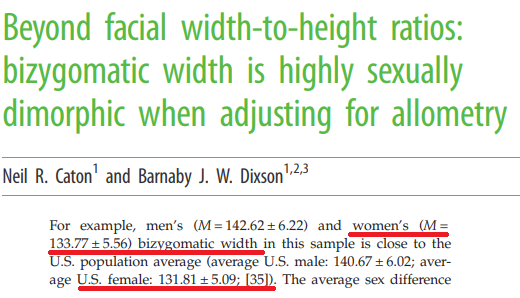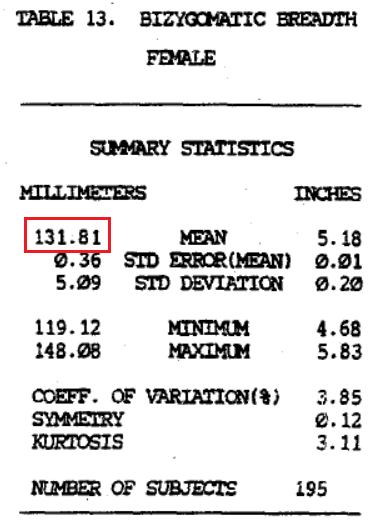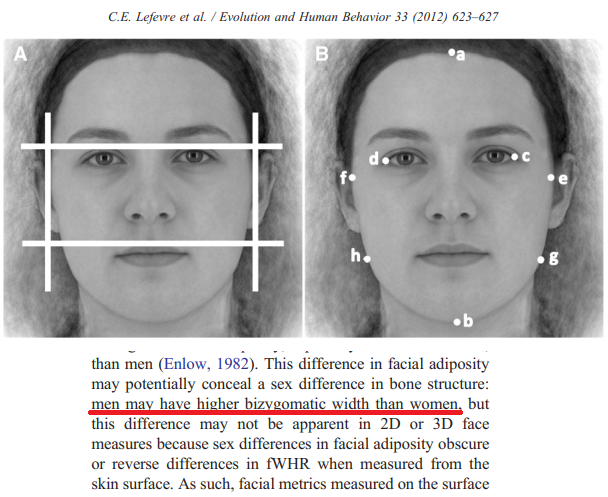Summary
The bizygomatic width, the distance between the cheekbones, varies between sexes, with men typically having a larger measurement. Caton and Dixson (2022) found that women’s mean bizygomatic width is 133.77mm. Young (1993) reported a slightly lower mean width of 131.81mm for women among U.S. civilians. Lakhiani and Somenek (2019) highlighted that despite men having larger bizygomatic widths, women’s forward-facing zygomatic prominence makes their cheekbones appear more pronounced, a desirable trait. Abitha and Santhanam (2019) also confirmed that men generally have wider cheekbones than women. Lefevre et al. (2012) found that men have higher bizygomatic widths, but their study focused on the lack of sexual dimorphism in facial width-to-height ratios across large adult samples.
Research
The bi-zygomatic width is the distance between the two zygomatic bones, or cheekbones. According to Caton and Dixson (2022) in their study titled “Beyond facial width-to-height ratios: bizygomatic width is highly sexually dimorphic when adjusting for allometry”, women’s mean bizygomatic width is 133.77mm.

Another study by Young (1993) intended to determine the bizygoamtic width among men and women among the U.S civilians. As per this study, the mean bizygomatic width for women is 131.81 mm.

A study by Lakhiani and Somenek (2019) suggested that the distance between the zygomatic bones (cheekbones) is typically larger in men as compared to women along with forward-facing zygomatic prominence making their cheekbones appear more pronounced. So, even if the bi-zygomatic width is smaller in females, this does not mean their cheekbones are less noticeable. Instead, the more anterior zygomatic prominence in women can enhance the perception of high, prominent cheekbones, which is often considered a desirable feature in females.
Similarly, another study by Abitha and Santhanam (2019) suggested that men generally have a larger bi-zygomatic width than women. The findings indicate that men typically have wider cheekbones compared to women.
Moreover, another study titled “No evidence for sexual dimorphism of facial width-to-height ratio in four large adult samples” by Lefevre et al. (2012) suggested that men have a higher bizygomatic width than women.

Reference
Caton, N. R., & Dixson, B. J. (2022). Beyond facial width-to-height ratios: Bizygomatic width is highly sexually dimorphic when adjusting for allometry. Biology Letters, 18(10), 20220211.
https://doi.org/10.1098/rsbl.2022.0211
Young, J. W. (1993). Head and face anthropometry of adult US civilians (No. DOT/FAA/AM-93/10). Civil Aerospace Medical Institute. https://rosap.ntl.bts.gov/view/dot/21363
Lakhiani, C., & Somenek, M. T. (2019). Gender-related facial analysis. Facial Plastic Surgery Clinics, 27(2), 171-177. https://www.facialplastic.theclinics.com/article/S1064-7406(19)30006-9/fulltext
Abitha, T., & Santhanam, A. (2019). Correlation between bizygomatic and maxillary central incisor width for gender identification. Brazilian dental science, 22(4), 458-466. https://bds.ict.unesp.br/index.php/cob/article/view/1775
Lefevre, C. E., Lewis, G. J., Bates, T. C., Dzhelyova, M., Coetzee, V., Deary, I. J., & Perrett, D. I. (2012). No evidence for sexual dimorphism of facial width-to-height ratio in four large adult samples. Evolution and Human Behavior, 33(6), 623-627. https://doi.org/10.1016/j.evolhumbehav.2012.03.002

